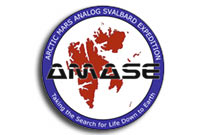NASA AMASE 2008: Great Whales o’ Fire!

August 8, 2008 / Written by: Marc
The SOWG (“S@#$, Oh Wow – Golly!”, I think) group has been working hard for the past few hours, performing simulated rover operations. One group is out in the field somewhere, shivering. The second group is in the common room of the R/V Lance, learning how to run a rover from within a closed room. All of the data we receive comes through the rover’s cameras (so far), although we have the option of requesting a wide range of measurements. We also have to move the rover, which takes time. These measurements include remote instruments such as PANCAM, NAVCAM (like those on the MER rovers), and the contact measurements Raman (yay!) and infrared spectroscopy. From there, we have the option of collecting a sample of an interesting rock or soil and conducting pyrolysis GC-MS (the SAM instrument), XRF/XRD using the Chemin instrument, nitrogen analysis, and caching for return to Earth. We can also use a ground-penetrating radar during traverses (the WISDOM instrument). I’ll spare you all the gory details of how each of these things work. I suggest an internet search for each name if you’d like to know more, but the short version is that we can analyze all manner of aspects of the rocks and surface around the rover. In order to assemble a complete picture of whether a location contains life, did harbor life, or could have supported life at some time in the past, we need to look at a complete picture of that site – hence the mineralogy, organic compound detection, imagery, spectroscopy, and close inspection in terrestrial laboratories. Finding life is easy if you’re in the Amazon and have eyes. Finding life becomes tricky business if you’re in a cold, low-atmospheric-pressure, oxidizing, irradiated, and remote place like Mars where your data trickles down like its coming through a soda straw. If you’re looking for remnants of long-dead life, then magnify the above a bazillion-fold. Ugh.
So – we’ve got this fairly daunting task, and have to assemble all these tools, equipment demands, and a room full of people into a usable data product. I must admit that I never fully appreciated just how difficult it is to quickly analyze the trickle of data, form a plan for collecting the next day’s (or Sol’s) traversing + data/imagery collection + what-not, assimilate that data into what we already know about the site from previous work, and try to plan a step ahead to the next data cycle. All of this has to be done on a scale of minutes, in a room full of people who are all feverishly churning through their own part of the data to turn it into something meaningful, from which the next round of decisions will be based, etc. etc. etc… It is an orchestra. If you like your orchestras working on a diet of Coke, and coffee, that is. We’ve got no time for legato around here!
Plus, the rover can break.
On top of all of that, the rover operations team needs to operate on a higher analytical level at the same time. The rover will find new, unexpected discoveries like “sand” composed entirely of silica, or “blueberry” outcrops, or meteorites on the martian surface. These things need to be integrated into the compendium of knowledge-goodness that we know about Mars, and once again folded into the next set of decisions on how to operate the rover. Squyres and his team do this with a real rover on a real, distant planet, with CNN and other idiot-journalists misinterpreting the findings as they go. Yeah, I’ve got a new appreciation for this process after just a few hours of a pared-down version of it, and my hat’s off to those guys and gals. I also find that I want more of it, ’cause I guess I can’t say no to the Coke, and coffee thing. Who knew that Mars rovers were addictive?!?
We have sent a set of commands to the rover, and now we wait for a few hours in an essentially windowless ship (we’re not supposed to look outside!) while it does its thing. This is something like sending the commands to Spirit or Opportunity, then waiting around for the next Sol’s uplink. It’s relaxing and maddening at the same time. So, now we wait …









